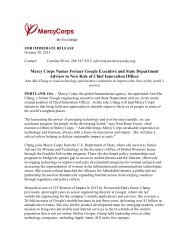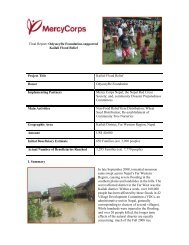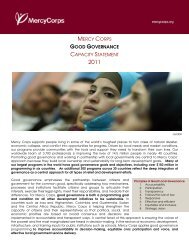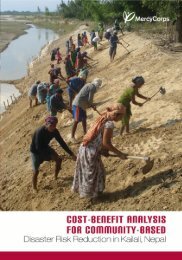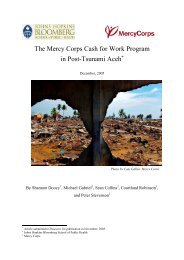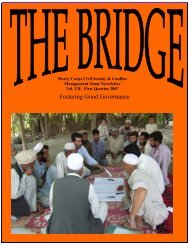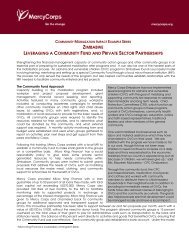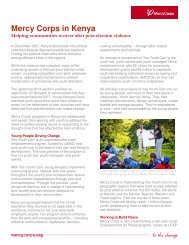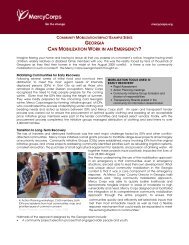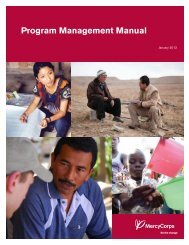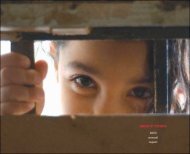healthy lifestyle alternatives to conflicts. A variety ofinterventions specifically targeted youth, though not allwere present in every PCI community. These included:international and regional youth summer camps, socialand skill-building projects, media projects, sportsevents, vocational trainings and social theater.Local NGO partners were actively utilized in theimplementation of PCI. In the initial three years of theprogram, individuals from the partner organizationsworked side-by-side with <strong>Mercy</strong> <strong>Corps</strong> staff on fieldteams that engaged in every aspect of the communitywork. This structure was intended to maximize skillsdevelopment that would then be transferred back tothe wider organizations. In reality, however, the teamsworked almost exclusively with PCI and had littlecontact with their host organizations. Therefore, inthe final two years of PCI, the approach was alteredSANDY SHEARD, 2007 FOR MERCY CORPSto allow partner NGOs to design, apply for andimplement independent projects for greater transfer ofimproved skills and experience throughout the partner organizations, particularly for proposal writing,budget development, financial and program reporting.PCI reported many impressive achievements from more than five years of implementation. Amongsome of the most noteworthy are:• 437 cultural and/or skill-building projects engaged at least two ethnic groups.• 137 program-funded community infrastructure projects were implemented.• 36 infrastructure projects completed for multi-ethnic or multi-community use.• 94 additional infrastructure projects implemented without donor funding.• 43 users’ groups established, receiving a total of 71 trainings in management, organizationalstructure, fee collection and maintenance of infrastructure projects.• Community contribution to infrastructure projects averaged 48% of the total cost.• 85% of the infrastructure projects benefited from government contributions.• 64 new businesses were created as a result of USAID-funded infrastructure projects.• 140 multi-ethnic youth projects were implemented.• Partner local NGOs received 19 grants from outside donors.50Sustainability Field Study
The Community Action Investment Program (CAIP)The goal of this far-reaching initiative was to “help prevent conflicts and promote broad basedcitizen dialogue and participation in target areas of Tajikistan, Uzbekistan and Turkmenistan; resultingin improved standards of living, more active and engaged citizens and more open, accountablelocal government”. CAIP targeted communities in Tajikistan, Turkmenistan and Uzbekistan, but asgreater restrictions were repeatedly placed on the organization in Turkmenistan by local authorities,<strong>Mercy</strong> <strong>Corps</strong> was forced to withdraw in the spring of 2003. Following termination of the program inTurkmenistan, <strong>Mercy</strong> <strong>Corps</strong> added communities in Kyrgyzstan to the program following the first year ofCAIP implementation. The program lasted from May of 2002 through June of 2005, with targetcommunities in Kyrgyzstan receiving support for just two of the program’s three years.In total, CAIP reached 65 core communities 29 and 216cluster communities. CAGs in each community werestructured to be representative of the larger communityand intentionally included all ethnic groups, womenand youth. <strong>Mercy</strong> <strong>Corps</strong> implemented CAIP in 3 areas:the Ferghana Valley (Uzbekistan since the start of theprogram and Kyrgyzstan, added in June 2003), and theRasht Valley and Khatlon regions of Tajikistan.The projects undertaken during CAIP includedcommunity-prioritized infrastructure projects, socialSANDY SHEARD, 2007 FOR MERCY CORPSevents and new economic opportunities. Theseprojects were designed to reduce sources of inter- andintra-community tensions by reducing competition over limited resources, providing outlets for networkingand connecting, building individual potential, and increasing business development in the region.Youth were targeted with skill-building activities intended to help them be more employable. Theeconomic development component of CAIP set up master-apprenticeship programs for youth in carpentry,plumbing and electrical skills. Mentoring programs were set up for tailoring and baking, whichprovided mentors with essential equipment in exchange for mentoring others in their trade. Youth werealso included on CAGs and were included in health education activities, leadership trainings andinteractive trainings, such as anger management, during sporting competitions especially organizedfor them.Similar to PCI, the CAIP program recognized that the lack of social services in communities wasgreatly contributing to tensions within communities, between communities and between communitiesand local government. Frequent complaints to authorities went unanswered as local government wasusually under-resourced to handle social service and infrastructure problems in the communities. CAIPactively sought to engage government officials in the community mobilization and project implementationprocess. Local officials often participated on CAGs or collaborated closely with them to monitorand support project identification and implementation. Nearly 90% of CAGs had a governmentofficial as a member, often the village leader or a technical department representative. The programtaught both government and community members to achieve results through a more collaborative,partnership-based approach to problem-solving and government officials took part in the many trainingsoffered to CAG members and others in the communities. Local government was also encouragedto contribute to helping communities meet their contribution shares, which would contribute to morepositive perceptions of the government’s concern for communities.29 This study sampled only core communities of CAIP, where the program was most active.Understanding What Promotes Lasting Change at the Community Level51



